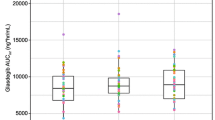Summary
Two nonblinded single-dose randomised 3-way crossover studies were conducted in healthy male volunteers to determine the effect of the time of administration (morning vs evening) and the effect of food on the pharmacokinetics of sertraline tablets.
There were no significant treatment effects on the mean area under the plasma concentration-time curve (AUC), mean peak plasma sertraline concentration (Cmax), mean time to reach Cmax (tmax), mean terminal elimination half-life, or the mean elimination rate constant in either study. The results of these 2 studies show that the bioavailability and elimination of sertraline tablets are not influenced by the time of administration or administration with or without food. Thus, sertraline tablets offer the flexibility of morning or evening administration, to patients in the fasting or nonfasting state.
Similar content being viewed by others
References
Greenberg RN. Overview of patient compliance with medication dosing: a literature review. Clin Ther 1984; 6: 592–9
Melander A, Lalka D, McLean A. Influence of food on the presystemic metabolism of drugs. Pharmacol Ther 1988; 38: 253–67
Fujimura A, Kajiyama H, Kumagai Y, et al. Chronopharmacokinetic studies of pranoprofen and procainamide. J Clin Pharmacol 1989; 29: 786–90
Physicians’ Desk Reference. 48th ed. Montvale, NJ: Medical Economics Data Production Company, 1994
Greb WH, Brett MA, Buscher G, et al. Absorption of paroxetine under various dietary conditions and following antacid intake. Acta Psychiatr Scand Suppl. 1989; 350: 99–101
Benfield P, Ward A. Fluvoxamine: a review of its pharmacodynamic and pharmacokinetic properties, and therapeutic efficacy in depressive illness. Drugs 1986; 32: 313–34
Wheeler SC, Vlasses PH, Dobinska MR, et al. Plasma fluvoxamine levels in fasted and fed subjects. J Clin Pharmacol 1985; 25: 463
Lemberger L, Bergstrom RF, Wolen RL, et al. Fluoxetine: clinical pharmacology and physiologic disposition. J Clin Psychiatry 1985; 46 (3 sec 2): 14–9
Tremaine LM, Joerg EA. Automated gas chromatographicelectron-capture assay for the selective serotonin uptake blocker sertraline. J Chromatogr 1989; 496: 423–9
Author information
Authors and Affiliations
Rights and permissions
About this article
Cite this article
Ronfeld, R.A., Wilner, K.D. & Baris, B.A. Sertraline. Clin-Pharmacokinet 32 (Suppl 1), 50–55 (1997). https://doi.org/10.2165/00003088-199700321-00008
Published:
Issue Date:
DOI: https://doi.org/10.2165/00003088-199700321-00008




